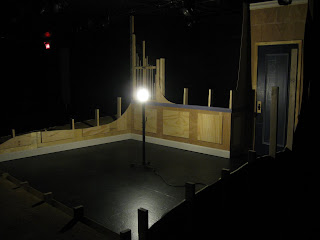Hurray! More apocalyptic suggestions! Today, our suggestions have to do with movies (or TV shows... or TV movies) that deal with end-of-the-world or post-apocalypse type scenarios. As London was seemingly experiencing the wrath of God in the mid-1660s (the Great Plague in 1664-5 and then the Great Fire in 1666), we figured to get you in the mindset of the characters of One Flea Spare, we'd give you some panic-inducing and slightly terrifying things to watch. [Oh, quick disclaimer: I have seen only one of the movies listed below, but the rest I recommend sheerly because from my research on them got me really intrigued. They're on my list now.]
To kick things off, we have the TV movie The Day After. I initially heard about this from a list of Apocalyptic songs that someone put together for an awesome college radio station near Baltimore. Then I found out that John Lithgow was in it. WHAT!?!??! I've been watching a lot of Third Rock from the Sun lately, so I love that guy. Anyhow, nuclear war, etc. etc. My take on it from reading about people's reactions was that it was like War of the Worlds for the TV generation. Pretty epic. And terrifying. I mean, it's set in the midwest, and as a middle-American, I find tornadoes terrifying, so nuclear disasters just make my brain want to explode with the panic it instills in me. AHH!
---
Next we have the recent movie 2012. With the tagline "We were warned," you can imagine the distances this disaster film takes us. O-ver the top. Haven't seen it, but my uncle told me, "Yeah, it makes you re-think the whole living in California thing." I'm not a huge John Cusack fan, so I don't know whether this movie will be at the top of my to-see list, but as it's in the end-of-the-world category, I'm sharing it with you.
---
Additionally, we should mention the History Channel's series Life After People. It's been on my list for a while. Take Chernobyl, then expand that across the globe. What would happen after all human life disappeared? Holy whoa, here's a show to speculate on the possibilities. This earth takes a whole lotta upkeep... in the human inhabited bits at least.
Of course, we would be remiss to neglect the genre of zombie-related apocalypse movies, as there are plenty of those and with zombies seemingly ever present in pop culture lately, so in that vein we have Zombieland. I haven't seen it, but take a look at the cast: Woody Harrelson - excellent in most everything he does; Jesse Eisenberg - did you see The Social Network? Wow. He's one to watch; Emma Stone - talented - I saw her in Easy A and was a little surprised I liked it, but anyhow, she's a good 'un; and Abigail Breslin - remember Olive from Little Miss Sunshine? It's the same young actress but a few years older and she looks like a bada** on the poster. Even though zombies aren't really my thing, I'm definitely going to check this one out. Plus, my boyfriend keeps telling me I need to see it.

In this zombie movie vein, Charlie keeps bringing up 28 Days Later. Yet another movie I haven't seen, but it's done by Danny Boyle and he's one talented fellow, so it's worth a watch.

In this zombie movie vein, Charlie keeps bringing up 28 Days Later. Yet another movie I haven't seen, but it's done by Danny Boyle and he's one talented fellow, so it's worth a watch.
And finally, for a slightly more family-friendly end-of-the-world movie, I highly recommend Disney and Pixar's Wall-E. Set in the future, it deals less with a sense of impending doom, disaster, and destruction and more with the aftermath of all that. However, viewing it from present day gives the kidlets (and parents) a chance to think about how present choices and actions affect the future and how to be mindful and make changes in positive ways. It also helps the viewer to find what is meaningful in your day-to-day life.
So, on that happy and hopeful note, have a great Thursday!
As always, we welcome your comments.














